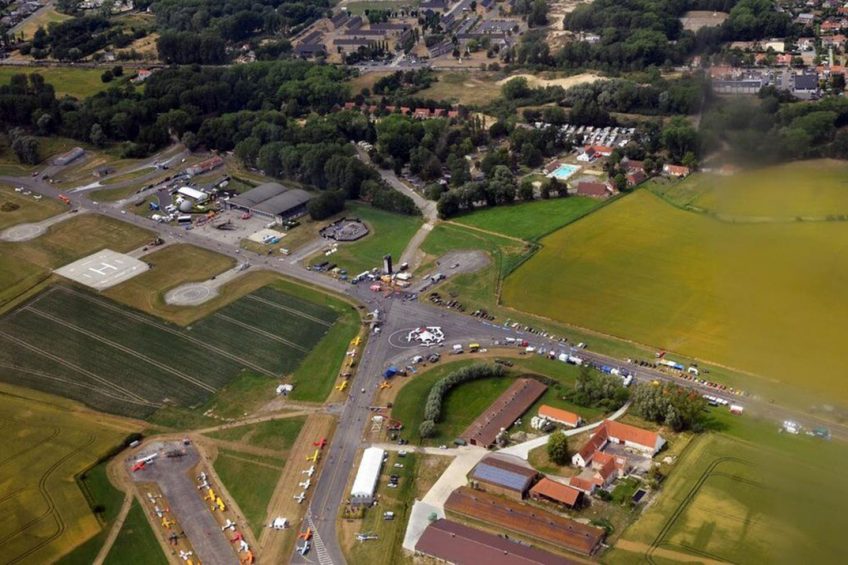Biosecurity by military design

Belgian broiler farmer Henk Ghyselen’s farm is located at an airbase in Koksijde, Belgium. Its airstrip also functions as the driveway to his farm. When he wants to expand he needs a municipal permit and NATO permission.
Ghyselen’s great-grandfather, Modest, married his wife in 1890 and moved to the farm’s current location in Koksijde. The pair did not have poultry. Henk Ghyselen took over the farm from his father at a young age in 1993; he was only 25 at the time. Wheat prices were so bad that he needed to find alternatives to keep the farm afloat. Broilers turned out to be a good option, in addition to the Belgian Blue cattle and the 45 hectares of arable farming they already owned. Ghyselen: “Broilers were an especially good option because we could feed our own wheat to them. The broilers’ manure went back onto the fields. So we already practiced circular agriculture which is all the fashion right now.”
Profile
Henk Ghyselen (52)
Koksijde (Belgium)
Ghyselen owns the farm together with Mia (48), Gerbert (20) and Sarah (22). They have 3 poultry houses with a total of 85,000 Ross broilers and 90 hectares of arable farming. The average feed conversion is 1.55. They unload in between rounds at 35 days (about 2kgs live weight) and the rest at 42 days. He has placed water misting installations in his poultry houses because of temperatures that reached 42°C during the summer last year.
Ideal and unique location
As far as its location goes, Ghyselen’s broiler farm is one of a kind. During the week, the noise of the broilers is regularly drowned out by fighter planes bursting into the stratosphere from the runway next to the farm. Visitors to the farm must first apply to the airbase commander because the farm’s driveway also serves as the airstrip. Security is strict, of course: no one can enter or leave without a security check. Armed guards with dogs keep the base and, by default, the broiler farm, safe. There are no unexpected, unannounced visitors and thus the Ministry of Defence ensures elementary biosecurity.
The airbase where Ghyselen operates his farm was built by the Germans during World War II. After the war, the Belgian Ministry of Defence took over the base and nothing has changed since. The farm is private property at a military location. Applying for expansion permits is not even that difficult, according to the broiler farmer. “In addition to permission from the Koksijde municipality and valid environmental permits, you need the airbase’s permission and even that of the air force, air traffic management and NATO itself.”
Technical results above expectations
Ghyselen built his first broiler house for 25,000 birds in 1993. He filled it with Ross chicks and the technical results were well above expectations. He was not worried that the broilers would suffer stress from the aircraft because his father used to have hobby poultry around the farm and these animals were not afraid of the noise either. “The broilers are not bothered by aircraft landing and taking off. Poultry are just not scared of sounds they do not know or are not used to.”
The good results meant that Ghyselen could build a second broiler house for 25,000 birds in 1995, followed by a third for 35,000 broilers in 2014, bringing the total number of birds to 85,000. He installed an Agro Supply heat exchanger next to the broiler house that yields a maximum of 12ºC heat gain. Back then it was not yet obligatory, but the family did get a subsidy from the Flemish government. Ghyselen: “The net return for the environment is lower though. The exchanger’s electric motors lead to a reduction in energy savings.”

Ghyselen also has heaters in his broiler houses that run on diesel. He finds it gives the most efficient yield of kilocalories because heat does not disappear and the gasoil does not create any harmful emissions. The straw that functions as a ground covering comes from Ghyselen’s own wheat. The broiler farmer owns a Fancom weighing installation and a mixer, so he can mix in up to 30% wheat. The broilers hardly suffer from sole lesions. “I don’t know the score exactly. They do measure it but they don’t really hold you accountable yet. There is talk of changing that, however,” he says.

Not bothered by activists
The day-old chicks come from Broeierij Lafaut, a breeding company based in both Belgium and France, and from Broeierij Ghekiere. Ghyselen: “I purposely obtain the chicks from 2 breeding companies to keep them on their toes.” The average feed conversion is 1.55. “We unload in between rounds at 35 days when they weigh around 2 kilograms (live weight).” Most of the chicks are caught with a catching machine used by the poultry service company Ghyselen works with.
Animal welfare continues to be a hot topic in Belgium and France, according to the broiler farmer. “Animal rights’ activists in Belgium, however, are more concerned with farms that produce foie gras and related products. Broiler farms are not that bothered by activists right now. I have the advantage that I am located on an airbase: animal rights’ activists would be arrested on the spot if they even got near the base. In France, people are now starting to become more assertive towards animal rights’ activists. They have even established a sort of civil defence organisation to protect their farmers.”
 European Commission criticised for its welfare position
European Commission criticised for its welfare position
Industry and welfare groups have joined in criticising the European Commission’s current legislative position on the welfare of farm animals.
Son takes over the farm
Succession is probably guaranteed because Gerbert (20), Ghyselen’s son, wants to take over the farm. At the moment he works as a furniture maker and operates his company from home. “The airbase has no problems with my son taking over,” says Ghyselen. For now, there are no plans for a fourth poultry house but the family is planning on replacing the old equipment and introducing some innovations. The inlet flaps in the 2 oldest poultry houses will be replaced by valves. Ghyselen hopes that by doing this he will be able to keep the climate in the poultry houses even better under control. “After 25 years, they really need to be replaced.”
Not least because the poultry farmer saw outside temperatures reach 42°C last year. Shockingly high, despite their proximity to the sea. “This is why we placed water misting installations in our poultry houses this spring. We hope to keep the temperature inside 8 degrees lower than it was last summer to prevent heat stress.”












